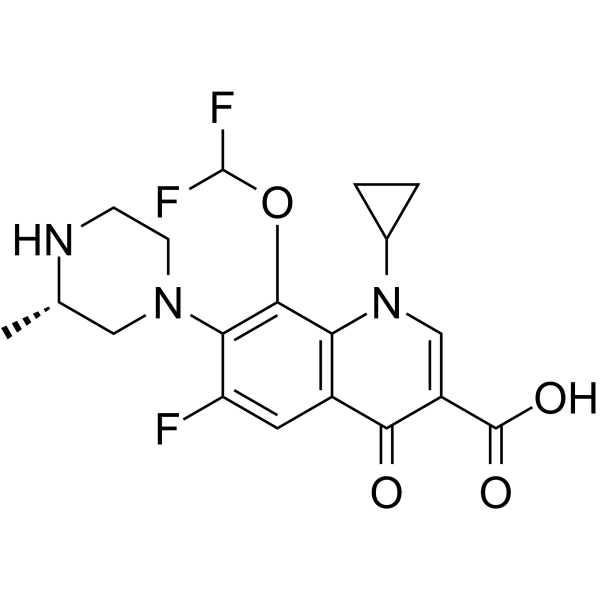153808-85-6
| Name | Cadrofloxacin |
|---|---|
| Synonyms |
3-Quinolinecarboxylic acid,1-cyclopropyl-8-(difluoroMethoxy)-6-fluoro-1,4-dihydro-7-[(3S)-3-Methyl-1-piperazinyl]-4-oxo
1-cyclopropyl-8-(difluoromethoxy)-6-fluoro-7-[(3S)-3-methylpiperazin-1-yl]-4-oxo-quinoline-3-carboxylic acid Caderofloxacin |
| Description | Cadrofloxacin (Caderofloxacin; CS-940), a orally active fluoroquinolone, is effective against aerobic/anaerobic Gram-positive and Gram-negative bacteria. Cadrofloxacin can be used for the research of infectious diseases[1][2][3]. |
|---|---|
| Related Catalog | |
| In Vitro | Cadrofloxacin against M.tuberculosis with a MIC50 of 0.25 μg/mL[1]. Cadrofloxacin against Acinetobacter spp. and Stenotrophomonas (Xanthomonas) maltophilia with MIC90s of 0.03 and 2 μg/ml, respectively[2]. Cadrofloxacin against Haemophilus influenzae, Moraxella catarrhalis, and Neisseria spp. with MIC90s less than or equal to 0.06 μg/mL[2]. Cadrofloxacin against members of the family Enterobacteriaceae with MIC90s of 0.015 to 16 μg/mL (median MIC90, 0.06 μg/mL)[2]. |
| In Vivo | Cadrofloxacin (9 mg/kg; i.g.; once or twice daily for 14 consecutive days) increases the activity of hepatic CYP2E1 in rats[2]. Animal Model: Male Sprague-Dawley rats weighing 180-220 g[2] Dosage: 9 mg/kg Administration: I.g. once or twice daily for 14 consecutive days Result: Enhanced the expression of hepatic CYP2E1 mRNA, inducing a 1.6-fold increase compared with that of control rats. The level of CYP2E1 protein in the hepatic microsomes was significantly higher than control group, 190% of that in control rats. |
| References |
| Density | 1.458g/cm3 |
|---|---|
| Boiling Point | 602.4ºC at 760mmHg |
| Molecular Formula | C19H20F3N3O4 |
| Molecular Weight | 411.37500 |
| Flash Point | 318.1ºC |
| Exact Mass | 411.14100 |
| PSA | 83.80000 |
| LogP | 2.96700 |
| Vapour Pressure | 2.33E-15mmHg at 25°C |
| Index of Refraction | 1.588 |
